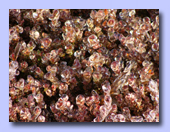|
Lesson Plan:
Overview
Background
Materials
Preparation
Step-by-Step
|
- Run the Challenges Await You Introductory Presentation. Afterwards, discuss some of the main points before focusing student attention on what’s going on in the spring. Some helpful questions include:
- The video begins by saying that the work for the next harvest begins right after the fall harvest. How is this so? What points from the video back up this idea?
- What are some of the things that can happen throughout the year to threaten a good harvest?
- What are some of the ways growers can meet these challenges?
- Draw students’ attention to the spring, in particular. Be sure they note that spring frost is an issue. Discuss why the spring frost can be a problem. Tell students that their challenge as growers is now to manage this threat. Review the idea that the response to a spring frost threat is to provide the bogs with a constant spray of water only when the temperature drops to a risky level.
- Tell students that they are going to have to make decisions about three evenings of potential spring frost. For each evening, they will need to examine the weather forecast and information about their bog to determine if there’s a threat and, if so, at what temperature they should ensure that their sprinkler system is turned on.
- Call the group together for a Growers’ Association meeting. Present Part 1(Managing Spring Frost) of the Chill Out Teacher Resource Presentation, which provides detailed information about frost threats and how to manage them.
- Distribute (to each pair or students) the Growers’ Association Brief, A Grower’s Guide to Managing Spring Frost. Tell students that the information they need to make it through the spring frost season with a healthy bog is in the brochure. Read and discuss.
- Distribute the Spring Frost Management Log sheet so students can track their decisions for each situation.
- If implementing advanced version: Direct students to open their bog’s A Risky Situation? Presentation Version 1, Blue Sky Bog or Version 1, Sunrise Bog.
If implementing simplified version: Direct all students to open A Risky Situation? Presentation Version 2
All versions of lesson: Direct students to consider Risky Situation #1 only. Provide students with 10-15 minutes to respond to this situation. In this time, they should read the brief and determine whether there is a threat and, if so, what to do about it and when. They should also complete their Spring Frost Management Logs for Risky Situation 1.
- Reconvene the Growers’ Association meeting, discuss the challenge, students’ solutions, and the reasons for their decisions. Present the Situation 1 slides from Part 2 (What Happened?) of Chill Out Teacher Resource Presentation. Stop after Risky Situation # 1.
Advanced version: All students will review both bogs’ situations. As their particular bog situation is reviewed, students should record the results in the appropriate space on their logs.
Simplified version: There is only one, generic Risky Situation 1. All students should record the results in their logs.
Remind students that even if they did not prevent frost damage at this time, all is not lost, and they still have a chance to be successful.
- In a similar fashion, run through the next two threat situations, alternating student work time with Growers’ Association discussion and feedback opportunities. After the third threat, ask students to sum up how they did. Discuss any remaining areas of confusion before moving on.
- Have students write reflections in their logs about their experience and the information they gathered during this phase of running the bog. What surprised them about spring frost concern? What might they do differently? What would they advise to other would-be growers regarding how to manage the bog?
- Congratulate all students, reminding them that some damage does not mean it is time to give up. They just have to be all the more on the lookout for other threats that they can manage for the rest of the growing season.
You may wish to proceed to another challenge. While it is not necessary to follow a particular order, in a given year, the next challenge that the grower would most likely face is managing insect pest populations.
|



